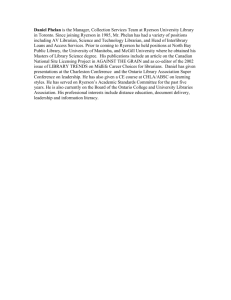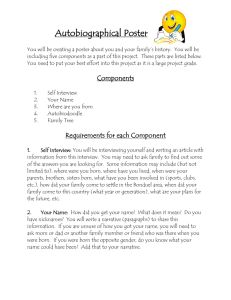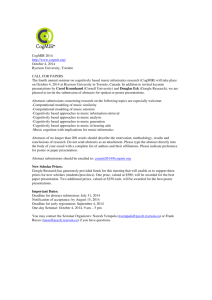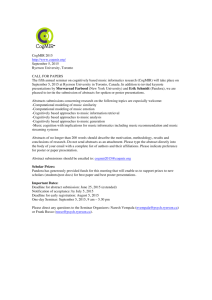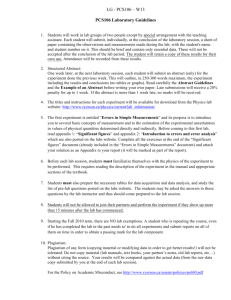BME100_CEAB_Outline_..
advertisement
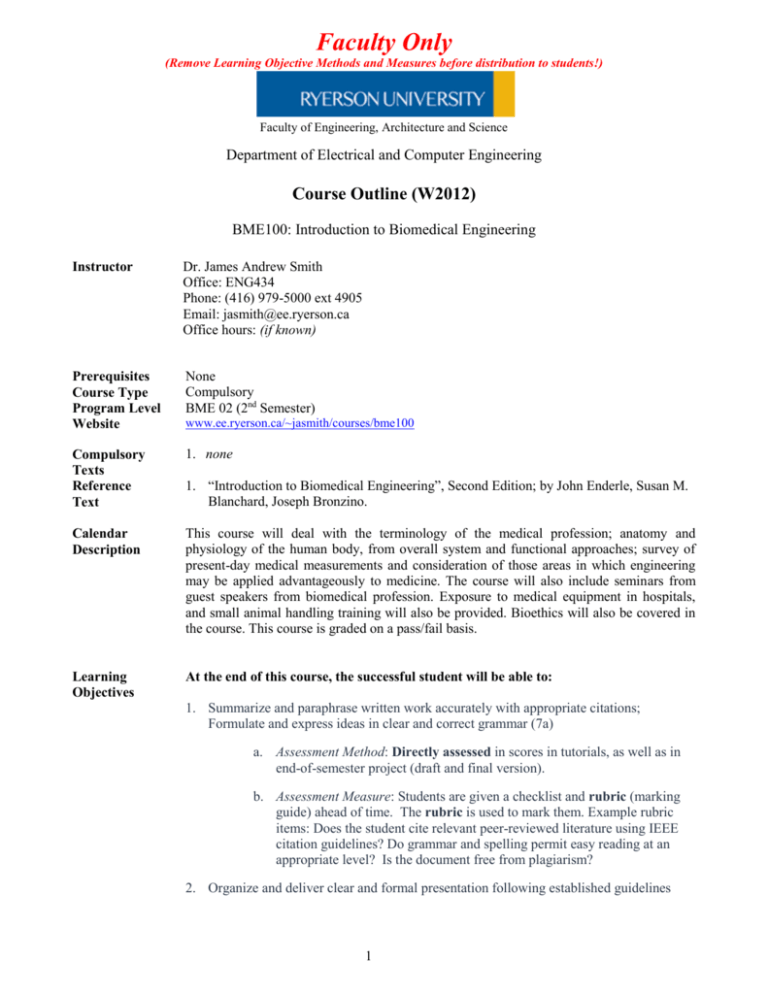
Faculty Only (Remove Learning Objective Methods and Measures before distribution to students!) Faculty of Engineering, Architecture and Science Department of Electrical and Computer Engineering Course Outline (W2012) BME100: Introduction to Biomedical Engineering Instructor Dr. James Andrew Smith Office: ENG434 Phone: (416) 979-5000 ext 4905 Email: jasmith@ee.ryerson.ca Office hours: (if known) Prerequisites Course Type Program Level Website None Compulsory BME 02 (2nd Semester) Compulsory Texts Reference Text 1. none Calendar Description This course will deal with the terminology of the medical profession; anatomy and physiology of the human body, from overall system and functional approaches; survey of present-day medical measurements and consideration of those areas in which engineering may be applied advantageously to medicine. The course will also include seminars from guest speakers from biomedical profession. Exposure to medical equipment in hospitals, and small animal handling training will also be provided. Bioethics will also be covered in the course. This course is graded on a pass/fail basis. Learning Objectives At the end of this course, the successful student will be able to: www.ee.ryerson.ca/~jasmith/courses/bme100 1. “Introduction to Biomedical Engineering”, Second Edition; by John Enderle, Susan M. Blanchard, Joseph Bronzino. 1. Summarize and paraphrase written work accurately with appropriate citations; Formulate and express ideas in clear and correct grammar (7a) a. Assessment Method: Directly assessed in scores in tutorials, as well as in end-of-semester project (draft and final version). b. Assessment Measure: Students are given a checklist and rubric (marking guide) ahead of time. The rubric is used to mark them. Example rubric items: Does the student cite relevant peer-reviewed literature using IEEE citation guidelines? Do grammar and spelling permit easy reading at an appropriate level? Is the document free from plagiarism? 2. Organize and deliver clear and formal presentation following established guidelines 1 Faculty Only (Remove Learning Objective Methods and Measures before distribution to students!) (7b) a. Assessment Method: Directly assessed in scores during end-of-semester presentations. b. Assessment Measure: Students are given a checklist and rubric (marking guide) ahead of time. The rubric is used to mark them. Example rubric items: Are time limits respected? Is the student capable of answering directed questions? Does the student’s electronic presentation refer to peerreviewed literature? 3. Demonstrate functional use of current software for written, oral and graphical communications in engineering contexts (7c) a. Assessment Method: Directly assessed in scores in both written and presentation components of end-of-semester project (draft and final version) b. Assessment Measure: Student is expected to follow checklist, template and rubric (i.e. marking guide). Example rubric item: Did the student present documents which were formatted in IEEE conference style? 4. Use figures and tables appropriately to compliment text (7d ) a. Assessment Method: Directly assessed in scores in written components of end-of-semester project (draft and final version). b. Assessment Measure: Students are given a checklist, document template and rubric (marking guide) ahead of time. Example rubric items: Are graph axes and title properly labeled? Does graphical data support the analysis in the text? 5. Describe ethical issues and how they affect individuals, companies and the public (10a) a. Assessment Method: Directly assessed in scores as a component in projects which involve ethics b. Assessment Measure: Students are given a checklist, document template and rubric (marking guide) ahead of time. Note: Numbers in parentheses (e.g. 10a) refer to the graduate attributes required by the Canadian Engineering Accreditation Board. For more information, see: http://www.feas.ryerson.ca/quality_assurance/accreditation.pdf Course Organization Course Evaluation 2 2 4 1 hours of lecture per week for 13 weeks, in 1 section hours of lab/tutorial every two weeks for 13 weeks Lab/tutorial sections of maximum 25 students Teaching Assistant, 4 sections per TA Participation Tutorials/Labs One Page Draft Final Project (Written) 20% 10% 10% 30% 2 Faculty Only (Remove Learning Objective Methods and Measures before distribution to students!) Final Project (Presentation) Total Examinations Project 30% 100% Note that BME100 is a pass-fail course. Students with a cumulative grade of 50% or more will be assigned a PSD (Pass) grade. No exams. Each project combines two separate components: a written component and a presentation component. Each is worth 30% of your final grade (they combine to be worth 60% of the final grade). Evaluation will be conducted based on the technical merit and the skill with which the student communicates his or her message. Depending on the project selection the presentation will take the form of a poster session or a formal multimedia presentation. Three main project categories are permitted: 1. Literature survey Four-page IEEE format literature survey 12 minute in-class multimedia presentation 2. Position paper Four-page IEEE format position paper Conference-style poster and poster presentation 3. Hands-on project with poster and public poster presentation Three-page IEEE format hands-on project report Conference-style poster and public poster presentation Week 3 – Select project topic (choose from a list of 100+ topics in three main categories). Week 5 - Hand in 1 page draft. (10% of final grade) Week 6 - Return of 1 page draft. Week 8 - Hand in draft poster. (10% of final grade) Week 10 – Return of poster Week 12 – Hand in written component (25% of final grade) and present project (25% of final grade) in a public setting. Week 13 – Open House REMARKS The end-of-semester projects are judged by faculty members within the context of the BME Open House and in-class presentations. The top three projects receive Departmental Awards. These awards ($500 for first place, $350 for second place and $200 for third place) take the form of reimbursements for academic activities such as conference attendance, etc. A limited number of runners-up (with no monetary award) are also chosen, depending on the quality of the projects. All awardees receive an official certificate. Course Content (lecture-by-lecture is best) 3 Faculty Only (Remove Learning Objective Methods and Measures before distribution to students!) Topic Introduction Sections n/a Hours 2 Writing & Presentation Skills n/a 4 Anatomy and Physiology n/a Biomedical Engineering Design n/a 2 8 - Topic, description Introduction to BME 100 (1 Hour) Project Requirements, Structure & Resources (1 Hour) Library resources & search techniques for peer-reviewed articles (Guest Lecture: Librarian; 2 hours); held at Library for hands-on session - Thesis Statements & Citations and Avoiding Plagiarism (Guest Lecture: Writing Centre; 1 hour) - Posters and Presentations (1 hour) - Introduction to Anatomy (1 hour) - Introduction to Physiology (1 hour) - Case study: Automated External Defibrillators (2 hours; including guest speaker & AED demonstration) - Manipulators and Surgery (1 hour) - Mobility and Rehabilitation (1 hour) - Seminar Discussion: When Implants Go Bad (1 hour) - Biomedical Sensors (1 Hour) - Engineering Tools (1 Hour) - Bio-inspired Engineering Design (1 Hour) Animal Use n/a 1 - Animal use in Biomedical Research (Guest Lecture; 1 hour) Medical Careers n/a 1 - Dual Careers in Engineering and Medicine (Guest Lecture; 1 hour) Ethics in Biomedical Research n/a 4 - Seminar Discussion: Autism and MMR Vaccines (1 hour) - Seminar Discussion: Nancy Olivieri and Apotex (1 hour) - Seminar Discussion: Denial of Science (1 hour) - Seminar Discussion: Taking care of Seniors (1 hour) - In-class presentations (4 hours) Student Presentations n/a 4 Laboratory/Tutorials Week 2,3 Title Annotated bibliographies Detail Pre-lab: Students are to read the three scientific articles, as well as an IEEE Citation Guide and the Annotated Bibliography handout. Lab: Articles and methodology is reviewed in the first half hour. Then, the students are to create a 4 Time 2 Hours Room n/a Faculty Only 4,5 6,7 8,9 10,11 (Remove Learning Objective Methods and Measures before distribution to students!) 50-75 word “Annotated Bibliographies” for each of the three articles. This should take approximately half an hour per article. The work is to be done in class, however any work conducted ahead of time may be used as an aid. Students may bring dictionaries and other writing aids. Computers are not recommended, as the written portion needs to be done on paper. Literature Surveys Pre-lab: Students are given a list of three 2 Hours bioethics articles to find using the Library’s online catalogue. They must read the articles beforehand, write an annotated bibliography of all three articles and bring them to the tutorial session. n/a Position Papers Lab: Using the annotated bibliography, the students are to write a 250 word survey of the three articles, linking the three together. No student opinions are to be discussed in this survey. They are also supposed to add a standard IEEE-format bibliography at the end. They are to hand in both the annotated bibliography and the literature survey. Pre-lab: Lab 2 must be completed. 2 Hours n/a Hands-On Projects Lab: Over the course of the two hours the students are to write a 250 word paper describing their position (opinion) of the three papers reviewed for the literature survey in the previous lab. The position (which is up to the student) is to be backed-up by their literature survey & the surveyed papers. The last page of the document is to be a standard bibliography. They are to hand in both the position (opinion) paper and the bibliography. Pre-lab: none 2 Hours n/a Project Finalization Lab: A presentation is given on “Palpation of the Arm” , the technique of locating parts of the body through touch. The TA will show the students how to identify various bones in the upper body and (primarily) the arm. Most parts are passive and will yield little feedback to the students. However, the Brachial Artery is an active landmark. Once the presentation is done, the students wil conduct a small scientific project in a standard format on the length of their forearm bones (ulna and radius). Emphasis is placed on the concepts of accuracy and precision in taking these measurements using average and standard deviation calculations. Pre-lab: none 2 Hours n/a Lab: During this session students will bring in the drafts of their final projects for review by the professor and teaching assistant. Feedback will be given on particular aspects of the project and questions regarding the written and presentation 5 Faculty Only 12 (Remove Learning Objective Methods and Measures before distribution to students!) components of the final project will be answered. Project Presentation Pre-lab: none 2 Hours n/a Lab: Each student must present the findings of their final project. Depending on the project selection the presentation will take the form of a poster session or a formal multimedia presentation. Depending on scheduling, some presentations may take place during regular class hours. Important Notes 1. All of the required course-specific written reports will be assessed not only on their technical/academic merit, but also on the communication skills exhibited through these reports. 2. All assignment and lab/tutorial reports must have the standard cover page which can be completed and printed from the Department website at www.ee.ryerson.ca The cover page must be signed by the student(s) prior to submission of the work. Submissions without the cover pages will not be accepted. 3. Should a student miss a mid-term test or equivalent (e.g. studio or presentation), with appropriate documentation, a make-up will be scheduled as soon as possible in the same semester. Make-ups should cover the same material as the original assessment but need not be of an identical format. Only if it is not possible to schedule such a make-up may the weight of the missed work be placed on the final exam, or another single assessment. This may not cause that exam or assessment to be worth more than 70% of the student’s final grade. If a student misses a scheduled make-up test or exam, the grade may be distributed over other course assessments even if that makes the grade on the final exam worth more than 70% of the final grade in the course. 4. Students who miss a final exam for a verifiable reason and who cannot be given a make-up exam prior to the submission of final course grades, must be given a grade of INC (as outlined in the Grading Promotion and Academic Standing Policy) and a make-up exam (normally within 2 weeks of the beginning of the next semester) that carries the same weight and measures the same knowledge, must be scheduled. 5. Medical or Compassionate documents for the missing of an exam must be submitted within 3 working days of the exam. Students are responsible for notifying the instructor that they will be missing an exam as soon as possible. 6. Requests for accommodation of specific religious or spiritual observance must be presented to the instructor no later than two weeks prior to the conflict in question (in the case of final examinations within two weeks of the release of the examination schedule). In extenuating circumstances this deadline may be extended. If the dates are not known well in advance because they are linked to other conditions, requests should be submitted as soon as possible in advance of the required observance. Given that timely requests will prevent difficulties with arranging constructive accommodations, students are strongly encouraged to notify the instructor of an observance accommodation issue within the first two weeks of classes. 7. The results of the first test or mid-term exam will be returned to students before the deadline to drop an undergraduate course in good Academic Standing. 8. Students are required to adhere to all relevant University policies including: - Undergraduate Grading, Promotion and Academic Standing, http://www.ryerson.ca/senate/policies/pol46.pdf - Student Code of Academic Conduct, http://www.ryerson.ca/senate/policies/pol60.pdf - Student Code of Non-Academic Conduct, http://www.ryerson.ca/senate/policies/pol61.pdf - Undergraduate Academic Consideration and Appeals, http://www.ryerson.ca/senate/policies/pol134.pdf - Examination Policy, http://www.ryerson.ca/senate/policies/pol135.pdf 6 Faculty Only (Remove Learning Objective Methods and Measures before distribution to students!) - 9. 10. 11. 12. 13. Accom.of Student Relig., Abor. and Spir. Observance, http://www.ryerson.ca/senate/policies/pol150.pdf - Est.of Stud. Email Accts for Official Univ. Commun., http://www.ryerson.ca/senate/policies/pol157.pdf Students are required to obtain and maintain a Ryerson Matrix e-mail account for timely communications between the instructor and the students. Any changes in the course outline, test dates, marking or evaluation will be discussed in class prior to being implemented. In-class use of cellular telephones is not permitted. Please turn off your cell phone prior to class. Quiet use of laptops, text-messengers and similar non-audible devices is permitted only in the rear two rows of class. This restriction allows use of such devices by their users while limiting audible and visual distractions to other students. This policy may change without notice. Assignments, projects and/or quizzes handed in past the due date and time will not be accepted for marking and will receive a mark of ZERO. Students found to have plagiarized any portion of their final project will receive a grade of zero on the complete project. This may lead to a failing overall grade. Course Developer ______________________________ Date ________________________________ Approved by _______________________________ Date ________________________________ Associate Chair, Program Director or Department Chair 7

